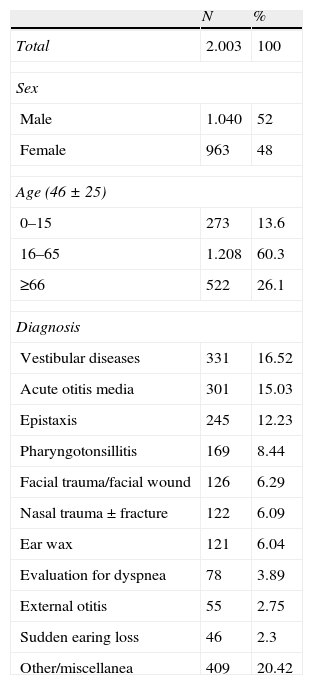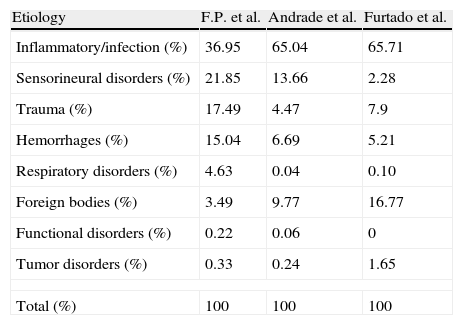Andrade et al. published on the May/June 2013 issue of this journal an interesting article on otorhinolaryngology (ENT) emergencies (“Profile of otorhinolaryngology emergency unit care in a high complexity public hospital”).1 The aim of this letter is to compare and comment what has been published to our data.
We retrospectively reviewed all patients sent for urgent/emergent consultation to our ENT emergency room (ER) from the general emergency department (ED) between two periods of time: from June 1 to July 31, 2012, and from November 1 to December 31, 2012. In our hospital, the protocol for referrals states that patients do not have direct access to the ENT ER and they need to be triaged by the ED consultant who establishes the level of urgency/emergency and the need for ENT evaluation. We considered all patients referred for evaluation through this way, thus excluding patients triaged in general practice (GP) and referred to us as planned consultation within 24h.
We collected 2021 ENT emergency cases: among these, 18 cases were excluded for lack of data. The remaining 2003 cases were included in the review. The mean age at presentation was 46±25 years old, with a median of 45 years. The demographic results and the ten most common diagnoses for referral are shown in Table 1.
Demographic results and list of the ten most prevalent diagnoses.
| N | % | |
| Total | 2.003 | 100 |
| Sex | ||
| Male | 1.040 | 52 |
| Female | 963 | 48 |
| Age (46±25) | ||
| 0–15 | 273 | 13.6 |
| 16–65 | 1.208 | 60.3 |
| ≥66 | 522 | 26.1 |
| Diagnosis | ||
| Vestibular diseases | 331 | 16.52 |
| Acute otitis media | 301 | 15.03 |
| Epistaxis | 245 | 12.23 |
| Pharyngotonsillitis | 169 | 8.44 |
| Facial trauma/facial wound | 126 | 6.29 |
| Nasal trauma±fracture | 122 | 6.09 |
| Ear wax | 121 | 6.04 |
| Evaluation for dyspnea | 78 | 3.89 |
| External otitis | 55 | 2.75 |
| Sudden earing loss | 46 | 2.3 |
| Other/miscellanea | 409 | 20.42 |
When classified for subspecialties, we found a lower rate of otological complaints (986 cases – 49.23% vs. 65.41% reported by Andrade et al.1 and 62.27% reported by Furtado et al.)2 and a higher rate of head and neck complaints (204 cases – 10.19% vs. 1.79%1 and 2.07%,2 respectively). The percentage values of rhinologic (20.77 vs. 17.99%1 and 18.55%,2 respectively) and pharyngolaryngostomatologic complaints (19.82% vs. 14.79%1 and 17.09%,2 respectively) can be considered similar. In our hospital, all patients triaged in the General ED and diagnosed with dizziness or vestibular impairment are referred to the ENT ED, unless they present with neurological symptoms. Thus, the vestibular disease is the most common diagnosis for ENT ED consultation and, in our series, accounted for 16.52% (331 cases) of all referrals. Among these cases, 30.4% were negative for a vestibular deficit, 34.4% had a benign paroxysmal positional vertigo, 9.2% a vestibular neuritis, and 26% was related to other causes (Ménière's disease, neurological or vascular symptoms, headache, etc.). This data highlights a different approach in diagnosis and treatment of vestibular diseases and demonstrates how ENT emergencies rate can vary depending on the type of management during patient triage. In our institution, a satisfactory level of competence in otology and neurotology has been reached in order to yield a prompt advice to general and specialist medical unites; the necessity of a strictly linked net of cooperation in this field is particularly considered.3 Our organization thus justifies the higher number of patients assessed for vestibular diseases during the considered period.
Conversely, our series presented a lower rate of inflammatory diseases compared to other studies1,2 although this diagnosis is still the most common (Table 2).
Percentage of cases in this series as compared to others according to the etiological subdivision by Cuchi Broquetas.4
| Etiology | F.P. et al. | Andrade et al. | Furtado et al. |
| Inflammatory/infection (%) | 36.95 | 65.04 | 65.71 |
| Sensorineural disorders (%) | 21.85 | 13.66 | 2.28 |
| Trauma (%) | 17.49 | 4.47 | 7.9 |
| Hemorrhages (%) | 15.04 | 6.69 | 5.21 |
| Respiratory disorders (%) | 4.63 | 0.04 | 0.10 |
| Foreign bodies (%) | 3.49 | 9.77 | 16.77 |
| Functional disorders (%) | 0.22 | 0.06 | 0 |
| Tumor disorders (%) | 0.33 | 0.24 | 1.65 |
| Total (%) | 100 | 100 | 100 |
The high rate for head and neck trauma consultation observed in our series (17.49%, 321 cases) also reflects the hospital protocols, which suggests ENT ED consultation for all the head injuries or wound (except for the orbital area). Patients are subsequently not referred to general, maxillofacial, or plastic surgeons as in other hospitals.4 This protocol can also explain the higher number of epistaxis and facial and nasal trauma among the ten most frequent diagnoses when compared to other series.1,2 A lower incidence of foreign bodies could be explained by the fact that, in our hospital, the reference team for consultation and treatment for upper gastrointestinal foreign bodies emergencies is the gastroenterological/endoscopic. Thus, all nose, ear, and mouth foreign bodies are always referred to the ENT ED.
Most cases of dyspnea are also primarily referred to ENT ED, rather than to anesthesiologists or pneumologists. This results in a higher rate of consultations when compared to other studies.1,2 In our series, 85 cases of respiratory disorders were observed, but only six (7.1%) could be considered true emergencies: two cases of bilateral vocal cord palsy that required emergency tracheotomy and four cases of laryngeal edema that required hospitalization.
The hospital admittance rate in the ENT ward was 2.1% (42 cases), mainly due to peritonsillar abscesses (18 cases, 42.9%).
Finally, following the etiological classification described by Cuchi Broquetas,5 we excluded 168 cases (8.4%), which could not be considered as true urgency/emergency according to Andrade et al.,1 such as ear wax, tinnitus.
We would like to highlight how the frequency of ENT emergencies could vary depending on the different management and competences of the specialist according to the institutional protocols.
Conflicts of interestThe authors declare no conflicts of interest.
Please cite this article as: Farneti P, Murri D, Pirodda A. Comparison of two different epidemiological profiles of otorhinolaryngology emergencies. Braz J Otorhinolaryngol. 2014;80:549–50.







